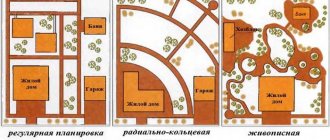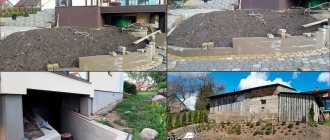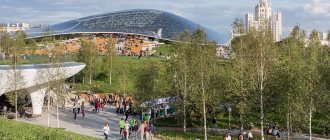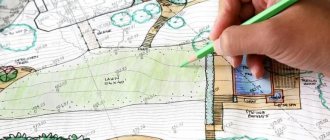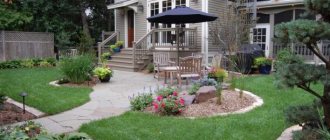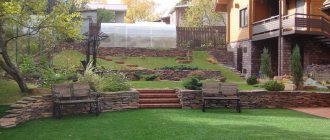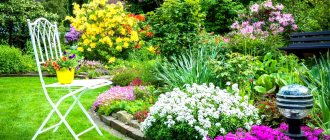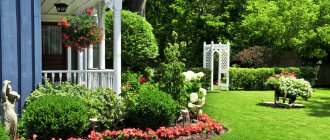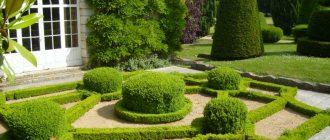People are becoming practical and demanding of their living environment. The practical, aesthetic, horticultural ecological sustainability of the landscape comes to the fore. Today, designer services are indispensable. Specialists implement customer ideas. They make the most incredible fantasies come true.
What is landscape design
A popular independent trend is part of landscape architecture. It lies in using the potential of the natural features of the landscape, which are transformed in the hands of the designer.
The three most important levels of landscape architecture:
- Landscape planning – design of suburban recreation areas, national parks, resorts.
- Design of botanical gardens, city boulevards, embankments and parks.
- Landscape design. Specialization - planning and designing a garden at a country house or on the roof; organizing a residential yard, arranging plants in the interior.
Landscape and its influence on our lives
To understand what landscape architecture does, it is important to have a clear understanding of what landscape is and what impact it has on people.
Tundra in Siberia. Photo: Dr. Andreas Hugentobler • CC BY 2.0 de
Landscape is the visible features of a piece of land, its relief and unity with natural or artificial objects. This is how the New Oxford American Dictionary defines this concept.
- Landscape includes the physical elements of geographically defined landforms, such as ice-covered mountain peaks,
- hills,
- bodies of water (rivers, lakes, ponds and seas),
- living things on the ground, including native vegetation,
- elements of human activity (various forms of land use, buildings and structures),
- as well as transitional elements such as lighting and weather conditions.
The landscape can be farmland, park or desert. The Earth has a vast variety of landscapes, including polar ice caps, mountain ranges, vast arid deserts, islands and coastal zones, forests and tropics.
The most important directions
Six components of landscape design:
- Urban planning and architecture. The task of specialized designers is to improve the space for the purpose of favorable life activities. In addition to aesthetics, it is important to create an ecological atmosphere in the urban jungle, change functionality and create comfort.
- Art and aesthetics. The picturesqueness of natural as well as man-made landscapes is important for everyday life. The aesthetics of the natural environment also plays a significant practical role.
- Ecology and botany. Environmental friendliness is a key trend in public life. Landscape designers create eco-barriers, fill the space with greenery, and saturate it with oxygen. They preserve the natural appearance of the garden, pond and landscape, and also combine plants correctly.
- Technique. When creating a project, designers use advanced technical developments. They create lattice lawns and dry streams, install automatic watering systems with diffusers. Innovative geomaterials prevent site deformation, displacement and soil collapse. Landscape lighting sets accents and creates exposure.
- Economy. Competent design optimizes estimate documentation and reduces the overall costs of project implementation. Specialists select inexpensive building materials, seeds, plants, tools and equipment.
- Sociology. A healthy natural environment affects the quality of life of citizens. The natural landscape, as a segment of the existence of social groups, is organized according to the needs of society.
List of sources
- https://studbooks.net/1093280/kulturologiya/istoriya_vozniknoveniya_razvitiya_landshaftnogo_dizayna_parkov_sadov
- https://svoyugol.by/istorija-landshaftnogo-dizajna/
- https://dizaynland.ru/stili-i-napravleniya/istoriya-landshaftnogo-dizajna
- Modern trends in the use of animation in advertising
- WWW (World Wide Web) - a global mechanism for information exchange (in the discipline "Layout")
- Professional software for editing and processing sound.
- Features of Sculpture in the era of Ancient Greece (XII - VIII centuries BC - the era of the birth of Greek sculpture)
- Leaders are born or become. Leader in the organization
- Ancient Greece sculpture
- Formation and development of the science of penal law: the genesis of its subject (History of the development of the subject of penal law)
- General principles of software engineering: efficiency, reuse, reliability, error tolerance
- Functional structure of enterprise management
- Legal regulation of the collection of compensation for moral damage in Russian civil law (Civil Law)
- Motivation - from theory to practice (Psychological Dictionary)
- History of landscape design from Ancient Egypt to Western Europe of the 20th century.
Popular Design Styles
Among the historical trends that had a great influence on the development of landscape design, we can highlight:
- a Scandinavian garden is a space with multi-level cascades, a natural slope, low shrubs and single plantings;
- Mediterranean and French regular garden - a luxurious natural space with figured flower beds, lace parterres, neat patterns;
- Provence style with a predominance of landscapes and herbs, characterized by rustic simplicity without luxury;
- an English landscape garden with elements of regularity, creates an atmosphere of antiquity, and is full of bright colors;
- Russian estate is a garden that combines naturalness and practicality, always complemented by small architectural forms, pavilions, gazebos, and ponds.
Examples of modern trends in landscape design:
- Natural gardens. Naturgarden spaces decorated in eco-style are in demand. They are as close to wild nature as possible. Such territories are far from an idyllic landscape and do not have figured plants and complex decorative compositions. Artificial materials are completely excluded. The goals of the direction are to recreate wild nature, demonstrate one’s own vision of beauty, and support the ecosystem. When decorating a garden, wild plants alternate with garden flowers. Green lawns have smooth shapes, and paths are intermittent and careless.
- Easy care garden. Corners of nature do not require tedious maintenance. Thanks to proper organization, they are easily maintained in their natural beauty. Practicality is achieved by the correct selection of plants, grouping, and selection of unpretentious species. Additionally, automated irrigation systems are installed. Exotic plants that require attention are excluded from seedlings. A guarantee of success is detailed design and thorough cleaning of the soil from weeds.
- Garden in minimalist style. Due to its practicality and freshness, such a design solution is very fashionable. It allows you to equip a compact local area and make it more well-groomed. Minimalism fits perfectly with urbanism. It is suitable for suburban cottages and townhouses. The design task is to preserve free space, create integrity, and the absence of barriers. The garden is distinguished by smooth, clear lines, shapes, and brevity. Concrete, wood, gravel, metal and even glass are used for arrangement. Changes and angles are neutralized by bushes and trees.
France, 17th century
Gardens appear in the Baroque style, which is borrowed from Italian solutions. Their layout is very simple, but they are generously decorated with flower beds.
Bright colorful parterres - broderies - are created from flowers. Natural forest areas are popular as places for horse riding and hunting. Water is used in the form of large, calm mirrors; channels and water parterres are popular.
The regular style used in the gardening art of France at that time laid the preconditions for the creation of future gardens.
Who is a landscape designer
A modern landscape designer is a manager, an artist, a designer and even a little designer. The specialist has interdisciplinary knowledge, as in his work he encounters related disciplines. He is savvy in architecture, civil engineering, geodesy and crafts.
The designer knows how to combine artistic design with technical knowledge. Therefore, he understands urban planning, the basics of composition, color, styles, materials, and the psychology of communication. To properly organize space, you will need knowledge in the field of soil science, botany, and engineering.
General characteristics of an English garden
- Lake. The English style always had a lake, most of which were man-made, but they all seemed to be natural pools. Their edges were twisted and uneven, and paths often led through trees and at the water's edge.
- Sloping Lawns – Topography allows for surprises as you approach hills or alcoves. Even if you create a small mound, it reflects nature better than a completely leveled landscape.
- Tree groves – scattered throughout the landscape with paths that allowed garden users to wander in and out of the groves and provide views of rolling lawns against a backdrop of mass tree plantings.
- Sculpture. The idea behind the English landscape was to offer views of classically detailed architecture and ruins from afar.
- Grottoes were used as romantic hideaways. They were man-made but resembled a dark, natural cave.
English style gardens were built on a large scale. However, it is still possible to create an English style garden in a residential landscape. Replicate areas in the English landscape style by reducing their scale. For example, if you don't have space to create a natural lake, you can easily depict it as a small pond. Tree groves can be reduced to form a small group, and a small wooden footbridge can be created by a small pond. Plant groups of flowers that will add color and a pleasant scent.
These gardens are designed to look natural and be a place for meditation and relaxation. This style values nature and encourages visitors to wander along gravel paths. The style has been shaped over the years to provide a balance of traditional formality. The English style of landscape design is guaranteed to bring a sense of mystery to your landscape.
What does a landscape designer do?
According to the definition of the Association of Landscape Architects of Russia ALAROS, a landscape designer is an expert with appropriate education and experience. Its activities are aimed at increasing the functionality and aesthetics of the surrounding space.
How does a landscape designer work:
- Immersion in the project. Consultations with the customer, full understanding of the tasks and requirements. Cooperation is built taking into account the characteristics of the land plot and the wishes of the client.
- Preparation of the project and its approval.
- The result is the development of all project documents (general plan, dendroplan, drawings, estimates, visualizations).
- The next stage is project implementation. Productive communication is built with related specialists.
- Design supervision or project support.
Formal
Formal style follows symmetrical patterns, straight lines and precise geometric shapes with neatly trimmed plants. Topiary can often be found in these landscapes. This style of landscaping requires a lot of maintenance.
Reflecting man's influence on nature, formal gardens are often characterized by well-defined structure and geometry. Organized around a central axis or path, formal garden designs emphasize symmetry in easily recognizable ground patterns. There is often sculpture or decorative design to create effect and focal point. The palette of materials is usually kept to a minimum, with gravel and regular paving stones. The main elements of planting are lawns and hedges, the latter being used to define spaces, edge borders or create flower beds. Adding height, folded trees can be introduced into the design to create orderly pathways, and decorative borders can be installed to soften the garden's strict geometry.
Landscape design trends in 2021
The more clutter there is in the garden, the less joy the owners get from it. An overly manicured landscape is annoying and frustrating. Modern designers try to maintain a balance. They create natural corners in which everyone feels comfortable.
Fashionable solutions in landscape design:
- Wild gardens. This style is characterized by lawns with lush grass, wild flowers and perennial grasses. A similar trend belongs to the author of the Dutch gardener Pieter Oudolf. In his works he tried to convey the effect of spontaneity and a sense of naturalness.
- Feeders, birdbaths and insect hotels. Birds and insects are essential participants in natural ecosystems. Their presence creates an incredible audio and visual atmosphere.
- Butterfly gardens. Bright multi-colored fluttering wings against the background of flowering plants - a similar trend is gaining popularity today.
- Spicy-aromatic beds and beautiful vegetable gardens. Lovers of natural vegetables, fruits, herbs, and spices have the opportunity to combine business with pleasure. Thoughtful compositions in the garden allow you not only to enjoy fresh produce, but also to make a banal garden bed more aesthetically pleasing.
- Mini-garden for 1-3 acres. A popular solution that has become widespread due to the widespread construction of townhouses.
- Monochrome gardens of the same color. Unique designs with full control over the palette transform any space. When planning plant placement, the change in color perception at different times of the day is taken into account.
- Collection gardens. Such landscapes are created in order to preserve endangered species, for aesthetic, collection, and scientific purposes. Creating collection gardening requires a professional approach, as well as careful selection of plants.
- Vertical gardens. They are created using container gardening on special supports with the help of vines and other plants.
Renaissance era
The Renaissance was marked by the planning and compositional unity of architectural ensembles. The Italian garden of that time is a solid, highly artistic work. All Italian Renaissance gardens have the following common features:
* The gardens are located on terraces and are connected by stairs. Stone is widely used, niches and grottoes are constructed. Terraces topped with balustrades and sculptures form the basis of an Italian garden;
* Wide application of water. It is used in the form of fountains and waterfalls, swimming pools and various ponds. The pond is the compositional center of Italian gardens;
* Mainly used. trees with a spreading roof: oaks and plane trees, sometimes cypresses; laurel, boxwood, and cypress are used to create hedges. Olives are used in plantings. A new technique appeared here for the first time - bosquet. The bosquet has a geometric outline and is limited to straight paths.
Inside there are trees, which are framed by row plantings or hedges. The widest range of flowering plants
* Great importance is attached to the color scheme of the garden, play with colors;
Informal landscape
Informal style uses flower beds with curved edges. Plants are arranged in random order. This would be a good choice if you have children who will play in the area.
Landscapes in this style, known for their abundance of flowers and planting, typically have a simple layout with a narrow central path of brick, stone, or gravel separating rectangular flower beds on each side. Hedges, rose arbors and arches are often used to divide the garden into different spaces that create different patterns and atmospheres.

